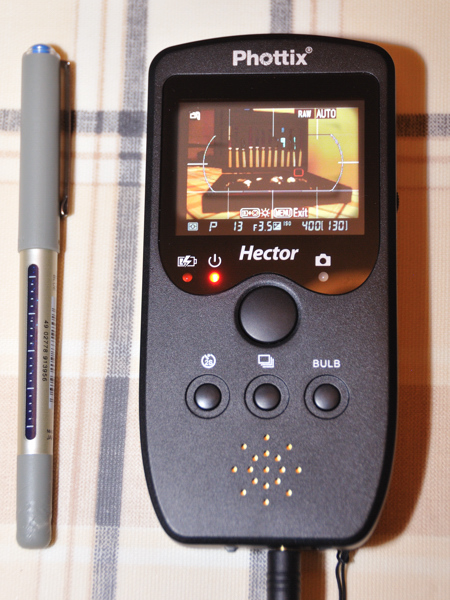Article
Phottix - Hector
| This is a device that connects to a camera
with Liveview, and allows the image through the lens to be seen on a hand
held device up to 2 metres from the camera, it also acts as a cable
release. It is powered by a rechargeable battery and comes with a power unit
to charge it in the unit. The battery is used for the Liveview feature, it
will function as a cable release even when the battery is flat or not
present. This will work with most DSLR cameras that
have a Liveview output. We are using it with a Nikon D300.
The image is displayed on a 2.4inch LCD
colour screen and although of poorer resolution than the rear panel on a
Nikon D300, it is adequate for its use.
Whatever would be displayed on the rear
panel of the camera is displayed on the panel, so you can see exposure
settings, the inbuilt metre and other settings, menu settings, images taken
etc as well as the Liveview image.
With the unit you get the appropriate cables for your camera. In the case of
a Nikon D300, this as a 2 metre cable that goes from the unit to two plugs,
one fitting the ten pin connector, the second a video out plug.
Image shows Hector and a pen
for size comparison
 |
 |
So why use it
-
Accessibility - It allows you to have
the camera in a position you cannot conveniently get to, for example high
up pointing down, low down pointing up, or on a monopod stuck out over the
wall of a castle or held high to look over a fence or crowd, and yet still
be able to see the image the camera can see.
-
Minimising disturbance - For panoramas
and situations where the camera is to move and you may either not wish to
move or moving might disturb the camera. For wildlife photography where
you might have the camera a little way from you, or your movements might
frighten the wildlife.
-
Covert - taking images without being
seen to do so, or with your camera around your neck, or with the camera
concealed. You could also operate the unit from inside a light proof bag
at night.
-
Candid photos - photos of children or
others, while watching them and not needing to be endlessly pointing the
camera at them.
-
Self portraits.
-
Alternative to a 90 degree finder - macro, manual focusing of long lenses, and the like.
-
Live 3D - for
this you need two cameras
looking at the same item, and while you can do this with Liveview and a
special dual camera support, if you want to use two tripods and have the
cameras further apart for landscapes, then being able to see one camera
and a second on a cable connection makes the task far simpler.
Available online from UK based
www.phottix.net
 price £89 plus £5 postage, including cables etc. (20% cheaper on stand at Focus
and possibly other shows). Extra cables to use with other cameras are
available. price £89 plus £5 postage, including cables etc. (20% cheaper on stand at Focus
and possibly other shows). Extra cables to use with other cameras are
available.
 
Hector in use Alternatives
In the studio and possibly elsewhere you can
run the camera connected to a computer, and control most camera features
and settings via a cable, as well as see the Liveview image ion the screen.
The
software to do this with a Nikon camera is Nikon Camera Control 2, you can
see an article showing its use in a project involving extended focus
(slicing) at
Capturing
Slices with
a Nikon DSLR.
 This works extremely well in the studio but is not very practical out and
about.
This works extremely well in the studio but is not very practical out and
about. The same company make a
more expensive non Liveview version model that will work on any camera
and looks through the viewfinder with a small camera/transmitter. This
model called the Phottix Hero, is wireless and can work up to
100metres from the camera. Price is £342.
www.phottix.net

Seculine Zigview S2 live similar to
this model costs £216 with a 6 metre cable.
Securline Zigview S2 non Liveview cable
version £249 plus adaptors and cables. Long cables are available.
The
Zigview
 models have an additional
function that allows movement in a section of the image to be detected and
this to fire the camera, however a camera cannot be left in Liveview mode
for an extended period, as after a short period the camera times out and
turns off to prevent the sensor from over heating. Zigview models
are
available from SpeedGraphic. models have an additional
function that allows movement in a section of the image to be detected and
this to fire the camera, however a camera cannot be left in Liveview mode
for an extended period, as after a short period the camera times out and
turns off to prevent the sensor from over heating. Zigview models
are
available from SpeedGraphic.
 |